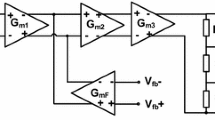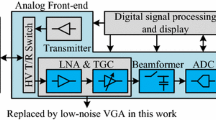Abstract
The design of a high stability voltage controlled current source (VCCS) for cervical cancer detection (CCD) applying electrical bio-impedance spectroscopy (EBS) is presented. The circuit was designed, simulated and fabricated in TSMC 130 nm CMOS technology at 1.3 V power supply. The proposed Howland current source is based on self-biased complementary folded cascode (SB-CFC) operational amplifier (OA). Complying with the requirements for medical electrical equipment of international standard ABNT-NBR-IEC-60601-1 the sinusoidal current peak amplitude was settled at 10 μA. In accordance with the requirements of the EBS for CCD, the specifications for the SB-CFC-OA were calculated to meet the 100 Hz–1 MHz frequency range for the sinusoidal output current and the output impedance higher than 1 MΩ at 1 MHz frequency. Post-layout simulations were run and the main results were: 10 ± 0.0335 μA for the output current peak amplitude over the specified frequency range and with 5 kΩ load impedance; values above 1.6 MΩ output impedance at 1 MHz; nominal current amplitude variations lower than 0.4 % for load impedances in the range of 10 Ω up to 5 kΩ. And the experimental result for maximum non-linearity was 2.19 % of full scale. From these results, the performance of the VCCS is adequate for EBS-CCD applications.










Similar content being viewed by others
References
Abdul, S., Brown, B. H., Milnes, P., & Tidy, J. A. (2006). The use of electrical impedance spectroscopy in the detection of cervical intraepithelial neoplasia. International Journal of Gynecological Cancer, 16(5), 1823–1832.
Brown, B., Tidy, J., Blackett, A., Smallwood, R., & Sharp, F. (2000). Relation between tissue structure and imposed electrical current flow in cervical neoplasia. The Lancet, 355(9207), 892–895.
Miranda, D. A. (2005). Detección Precoz de Cancer de Cuello Uterino basada en Espectro de Impedancia Eléctrica. In U. I. d. Santander (Ed.), Bucaramanga: Disertación Tesis de Maestría.
Barrow, A. J., & Wu, S. M. (2007). Impedance measurements for cervical cancer diagnosis. Gynecologic Oncology, 107(1), S40–S43.
Tucker, A., Fox, R., & Sadleir, R. (2013). Biocompatible, high precision, wideband, improved Howland current source with lead-lag compensation. IEEE Transactions on Biomedical Circuits and Systems, 7(1), 63–70.
Bertemes-Filho, P., Felipe, A., & Vincence, V. (2013). High accurate Howland current source: Output constraints analysis. Circuits and Systems, 4(7), 451–458.
Zanganeh, M. (2013). A new high output wideband ac current source with high current swing authority for electrical impedance tomography applications. International Journal of Computing and Network Technology, 1(3), 205–213.
Allen, P. E., & Holberg, D. R. (2012). CMOS analog circuit design (3rd ed.). New York: Oxford University Press.
Sai Praneeth, G., & Saini, A. (2009). A self biased operational amplifier at ultra low power supply voltage. In 16th IEEE International Conference on Electronics, Circuits, and Systems, ICECS 2009.
Magnelli, L., Amoroso, F. A., Crupi, F., Capuccino, G., & Iannaccone, G. (2012). Design of a 75-nW, 0.5-V subthreshold complementary metal–oxide–semiconductor operational amplifier. International Journal of Circuit Theory and Applications, 42(9), 967–977.
Aguilera, O., Bayona, O., & Miranda, D. (2007). Design criteria of Howland current source. UIS Ingenierías, 6(1), 59–68.
Ceperic, V., Butkovic, Z., & Baric, A. (2006). Design and optimization of self-biased complementary folded cascode. In Electrotechnical Conference, 2006. MELECON 2006. IEEE Mediterranean.
Mandal, P., & Visvanathan, V. (1997). A self-biased high performance folded cascode CMOS op-amp. In Proceedings of Tenth International Conference on VLSI Design, 1997.
Song, B., Kwon, O. J., Chang, I., Song, H. J., & Kwack, K. (1999). A 1.8 V self-biased complementary folded cascode amplifier. In The First IEEE Asia Pacific Conference on ASICs, AP-ASIC’99.
Silverio, A., & Silverio, A. (2012). A high output impedance current source for wideband bioimpedance spectroscopy using 0.35 μm TSMC CMOS technology. International Journal of Engineering and Applied Sciences, 1(2), 68–75.
Acknowledgments
The authors wish thank CNPq—Brazilian National Council of Scientific and Technological Development for support and collaboration.
Author information
Authors and Affiliations
Corresponding author
Rights and permissions
About this article
Cite this article
Amaya Palacio, J.A., Van Noije, W.A. High stability voltage controlled current source for cervical cancer detection using electrical impedance spectroscopy. Analog Integr Circ Sig Process 89, 541–547 (2016). https://doi.org/10.1007/s10470-016-0828-8
Received:
Revised:
Accepted:
Published:
Issue Date:
DOI: https://doi.org/10.1007/s10470-016-0828-8




